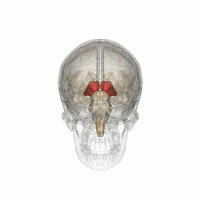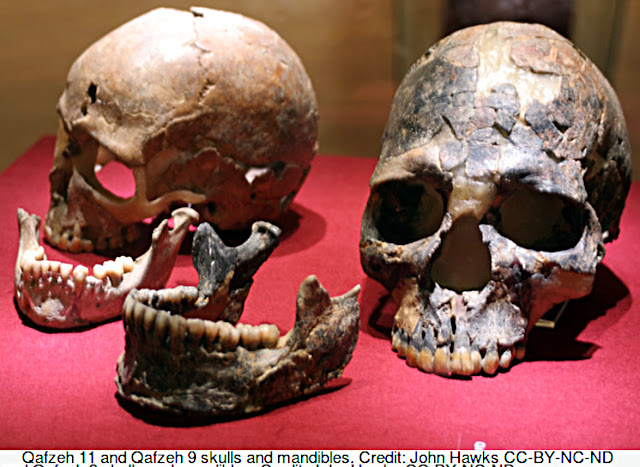John Hawks: Both the Altai Neandertal and Denisovan genomes share many haplotypes with the genomes of living Africans, including haplotypes that are polymorphic within Africa, and many that are rare elsewhere in the world. This kind of sharing is the inevitable result of incomplete lineage sorting from the common ancestors of Africans, Neandertals, and Denisovans.
Klevius: “Deep coalescence” or “incomplete lineage sorting” refer to the failure of gene copies to coalesce within the duration of the species – the lineages coalesce in an ancestral species.
John Hawks: But haplotype length decreases as time passes since these common ancestors were shared. If there had been no subsequent gene flow from Africans, the Neandertal and Denisovan genomes would have the same distribution of haplotype lengths shared with African genomes, even for that set of haplotypes that are specifically African today, shared with one African genome and not others.
Klevius: Which fact is in good accordance with pre-human ancestors in Africa mixing with erectus(?)/Heidelbergensis/Denisovan/Neanderthal and Homo sapiens/HSS in a pattern where sub-Saharan Africa retained the least mixture and east/north Africa the most.
John Hawks: The fact that the Neandertal shares more long haplotype blocks with living Africans is evidence for gene flow between them. The lengths give an estimate of the timing, which seems to have been around 100,000 years ago.
Klevius: 100,000 years ago is equal or more recent than the most likely dating of the Liujiang skull in China. And we do know that Eurasia possessed a more delicate mongoloid type of humans before Africa (at least as it stands now). However, we also know that Eurasia harboured Neanderthals and Red Deer Cave people long after the appearance of truly modern HSS.
John Hawks: Let me briefly propose a hypothesis that I’m not sure I fully support, but is the sort of thing many anthropologists might arrive at:
1 Many anthropologists think that the human remains from Skhul and Qafzeh in Israel, both dating to the interval between 90,000 and 110,000 years, represent a modern human population with substantially African ancestry.
2 Many anthropologists think that some later skeletal samples in the same region, including skeletal remains from Amud, Dediriyeh, and Kebara, all dating after 90,000 and before 40,000 years ago, represent a population movement of Neandertals into West Asia, that may have supplanted the Skhul-Qafzeh population.
3 If these assumptions about population affinities were correct, then maybe the modern humans who are found at Skhul and Qafzeh were actually part of a broader dispersal into parts of western Asia, and maybe South Asia, for which we have no skeletal evidence. This population continued to exist in other parts of West Asia even as a more Neandertal-influenced population occupied the Levant. This population was the ancestor of the modern human component of the Altai Neandertal genome.
Now, I do not fully accept propositions 1 and 2. I am not convinced that Skhul and Qafzeh did not represent a substantially admixed population already, and I am not convinced that the Levantine Neandertals are necessarily very Neandertal at all. But even a substantially admixed early population might explain the introgression of genetic material similar to Africans into the Altai.
Klevius: Skhul and Qafzeh seem far from mongoloid yet possess slightly Cro Magnon (and African) type eye orbits. This would be logical as a consequence of mixing from eastern Eurasia to the west and south. These humans probably also constituted the forefathers/mothers of the Khoisan "race".
John Hawks: Kuhlwilm and colleagues looked at areas within the Altai Neandertal genome that are most similar to African genomes, and are therefore candidates for gene regions that came into the Neandertal population from modern human introgression. They find some interesting hits:
Seven segments exceed 200 kb (Table 2) and the longest one (309 kb) overlaps with a region suspected to have been under positive selection in modern humans3. This region has a transcription factor gene (NR5A2) involved in liver development16. One segment of 150 kb is located within the FOXP2 gene (Table 2), which encodes a transcription factor that may be relevant for language acquisition.
This hit with FOXP2 could be chance, but who knows? Maybe this and other genes important to language today were spreading. If these were not already language-using hominins, such a gene would be unlikely to have any utility in their population.
At the very least, functional analysis may help to think about how the genes of modern humans were dispersing through thousands of miles of Neandertal territory, for tens of thousands of years.
Klevius: Our strongest evidence for functionality is the sudden appearance of the Denisova bracelet, art and a series of portraits from Baykal to the Pyrenees on a level not seen anywhere before. Yet thses are the least discussed - probably that they are found "in the wrong place".
Klevius advise to the shy ones: Looking down to see the stars isn't helpful.
Khoisan (Khoesan) have generally lighter skin, epicanthic eye folds, dental shoveling and prominent cheekbones, although most are heavily mixed with Bantu. They must have looked even more mongoloid before the Bantu invasion.Hi folks,
got this comment on an old posting:
It´s this pro-Mongoloid data supported by many ancient skulls? That modern type skull from China, is already well dated and to which race type was assigned? Any scientific study about the oldest Mongoloid skulls? Many of those skulls used for comparison aren´t complete, visual comparisons done between living people and skull fossils without any measurements, are too difficult. Never read any published article, comparing Kostenki with living people. Never read any study stating that Africans left Africa as pygmies and returned as Mongoloid... There´s any study about Mongoloid skulls from Africa? There´s no data to suggest that Scandinavians are the oldest Europeans. Sorry, this is just my opinion. on Debunking the "out-of-Africa" myth: Africa wasn't cold enough to produce mongoloids* - and modern humans. So why were the first Africans mongoloids?
Klevius answer (apologizes for the tone but transfers it to the commentator who obviously didn't think Klevius logic was worth considering):
You may really learn to read, buddy!
1 Africa's native population was and is mongoloid. Take a look if you aren't also blind.
2 Mongoloid features developed in the cold, i.e. not in Africa.
3 The truly African gene component is more than a million year old and according to physical anthropology, pygmy sized. And Cope-Depéret's rule states that in straight evolution lines of non-flying animals the size of species increases, not the other way round).
4 Of course you haven't read (as yet) others than Klevius writing/researching from this aspect - this is why you had to read Klevius to even know about it. And dude, that's precisely why Klevius (since he published a book about it in 1992) keeps writing about it until others are forced to pick up this inevitable thread. Homo floresiensis and the Denisovan genome has since strengthened Klevius theory to a point where it's now by far the best when it comes to explaining the overall pattern (not details) of human evolution.
5 Einstein's theory wasn't "supported" by previous studies. How could it possibly have been studied before it existed? Or maybe you don't trust Einstein either...
6 And dude, don't feel sorry for anything else than your careless reading of what Klevius has written.
African genetic diversity is a result of hybridization between proto-humans and Eurasians
Y-DNA A and B which are almost exclusively African are more basal, than the Y-DNA CF clade, which makes up the lion's share of non-African Y-DNA. mtDNA L0, L1 and L2 which are almost exclusively African are more basal than Y-DNA M and N which makes up virtually all non-African mtDNA.
There doesn't exist any old African DNA - so those who shout about "data" and "studies" have absolutely no reason at all to believe in an out of Africa scenario. However, even without African DNA it's easy to conclude that the population pattern, physical anthropology etc. we see now as well as in prehistory does support the very opposite namely an into Africa migration/hybridization causing the most diversity in the most remote parts, i.e. sub-Saharan Africa.
Genetic evidence from Khoisan-language speakers in southern Africa suggest an origin "along the African rift and a possible wider East African range." Thus, the Bushmen of the Kalahari who occupy the largest geographic region where click languages are spoken are viewed as a relict population far removed from the place where click languages probably originated. The Khoe languages, Tuu languages, Kx'a languages, Hadza language and Sandawe language (the latter two being Tanzanian language isolates) are frequently grouped together.
For the Khoe-Kwadi group, a more recent origin by immigration from East Africa has been suggested based on similarities with Sandawe. This is in line with a pattern of bantu speakers taking over the habitats of Khoisan people. This is also in line with a much earlier "backmigration" from Asia.
The oldest extant human maternal lineages include mitochondrial haplogroups L0d and L0k found in the southern African Khoisan.
L0d is the earliest diverged lineage (∼172 kya, 95%CI: 149-199 kya), followed by L0k (∼159 kya, 95%CI: 136-183 kya) and L0g (∼94 kya, 95%CI: 72-116 kya). Subclades L0d1d and L0d1c4/L0d1e estimates L0d2 and L0d1 divergence at ∼93 kya (95%CI:76-112 kya).
The genetic Khoe identifier has a broad maternal representation, likely reflective of a migratory prehistory. Specifically, L0d1c (19.5%), L0d1b (17.1%), L0d2c (17.1%), L0d2a (14.6%), L0k1a (12.2%) and L0d1a (9.8%). Elevated frequencies of L0d2a within the Southern Bantu (41.5%), Coloured (34.8%) and Baster (33.3%) populations, further supported by previous estimations within the Karretjie (58.1) and absence within the #Khomani, suggests a once broad west to eastern coastal distribution of the L0d2a ancestral lineage. Significant representation of L0d1a within the Coloured and Baster populations (26%), and previously reported for the #Khomani (43%), suggests a south to southwesterly ancestral dispersal. The L0d1b ancestral lineage appears to have been highly dispersed throughout southern Africa.
The predominance of L0d2a and L0d1a in non-Khoesan populations suggests a once independent coastal Khoesan prehistory.
In sum: A migration from Asia to Africa is an explanation not only to the mongoloid features but also to genetics.
Neanderthal to the left and Homo sapiens sapiens (Cro Magnon/Western Europe).
Cro Magnon side view. Broad cheekbones and a wide face came from Asia - npt from Africa or Mideast where the forms were just the opposite.
And here's how Homo sapiens looked like when they had moved from Asia to the West and got mixed with more archaic forms and simultaneously diluting mongoloid traits.
Qafzeh 9
Skulls from approxim. 100kyr found in Israel. Compare these to Liujiang below.
Klevius wrote:
Thursday, March 15, 2012
The Red Deer Cave people add more evidence for Klevius’ ape/homo hybridization theory
The irrefutable art track in Northern Eurasia (see map below) has no contemporary equivalent in other parts of the world. Based on what we know now it had no fore bearers whatsoever in any period of time. Moreover, it seems that there was even a decline before "civilizations" started tens of thousands of years later! Yet Klevius seems to be the only one addressing this most interesting (besides genetics) fact! According to Klevius (and no one else so far) the new and more efficient brain evolved in a jungle environment (SE Asia?) and spread up until meeting with big headed Neanderthals hence creating the modern human who later spread and dissolved with archaic homos. In this process Homo erectus was most probably involved as well.
Updated info about the origin of Klevius' theory
Keep in mind that mainland SE Asia possibly harbored physically truly modern humans already before the time range (12,000/18,000 ybp - 98,000 ybp) of the Homo floresiensis remains in the Flores cave.Liujiang, SE China (est. 100,000-140,000ybp)
If this Liujiang skull had been found in Africa or Mideast Wikipedia and other media would be overfilled. But this is all you get now (summer 2015 update) from Wikipedia about this extremely important skull:
The Liujiang skull probably came from sediment dating to 111 000 to 139 000 which would mean it's older than the oldest Homo floresiensis remains on Flores. Nothing even remotely close to this modern skull has ever been found in Africa, Mideast or Europe this early. In other words, we have the extremely archaic looking Red Deer Cave people 100,000 years after this extremely modern looking Liujiang population at approximately the same region. Even the least probable estimate of 70,000 bp would make Liujiang more modern looking than anything else.
Also compare Lake Mungo remains in Australia with an mtDNA that differs completely from ours (incl. Australian Aborigines). Sadly the remains have been kept out of further research because of stupid* "Aboriginal"(?!) greed (for the purpose of making certain people more "special" than others for no good reason at all (also compare the ridiculous Kennewick man controversy). Does it need to be said that the Mungo remains are as far from Australian Aborigines in appearance as you can imagine. However, according to Alan Thorne, 'Mungo could not have come from Africa as, just like Aboriginal Australians don't look like anybody from Africa, Mungo Man's skeleton doesn't look like anybody from Africa either. LM3 skeleton was of a gracile individual, estimated stature of 196 cm, which all sharply contrast with the morphology of modern indigenous Australians. Compared to the older Liujiang skull Mungo man had a much smaller brain.
* There's no way anyone can state who was "first" in Australia - and even if there was, then there's still no way of making any meaningful connection to now living people.
In Demand for Resources (1992:28 ISBN 9173288411) in a chapter about human evolution, Peter Klevius used only one example, the remarkable Jinniushan skeleton/cranium:
In northern China near North Korean border an almost complete skeleton of a young man who died 280,000 years ago. The skeleton was remarkable because its big cranial volume (1,400cc) was not expected in Homo erectus territory at this early time and even if classified as Homo sapiens it was still big. The anatomically completely modern human brain volume is 1,400 cc and appeared between 50-100,000 years ago. One may therefore conclude that big brain volume by far predated more sophisticated human behavior (Klevius 1992:28).
Today, when many believe the skeleton is female, the brain size becomes even more remarkable.
Updated map
Most "mysteries" in genetics disappear by abandoning OOA and changing direction of HSS evolution. Only South East Asia offered a combination of tropical island/mainland fluctuations needed to put pressure on size reduction paired with evolutionary isolation in an environment where only those survived who managed to shrink their heads while keeping the same intelligence as their mainland kins with some double the sized brain. Homo floresiensis is evidence that such has happened there.
Denisovan is an extinct species of human in the genus Homo. In March 2010, scientists announced the discovery of a finger bone fragment of a juvenile female who lived about 41,000 years ago, found in the remote Denisova Cave in the Altai Mountains in Siberia, a cave which has also been inhabited by Neanderthals and modern humans. Two teeth and a toe bone belonging to different members of the same population have since been reported.
Analysis of the mitochondrial DNA (mtDNA) of the Denisovan finger bone showed it to be genetically distinct from the mtDNAs of Neanderthals and modern humans. Subsequent study of the nuclear genome from this specimen suggests that this group shares a common origin with Neanderthals, that they ranged from Siberia to Southeast Asia, and that they lived among and interbred with the ancestors of some present-day modern humans, with about 3% to 5% of the DNA of Melanesians and Aboriginal Australians deriving from Denisovans. DNA discovered in Spain suggests that Denisovans at some point resided in Western Europe, where Neanderthals were thought to be the only inhabitants. A comparison with the genome of a Neanderthal from the same cave revealed significant local interbreeding, with local Neanderthal DNA representing 17% of the Denisovan genome, while evidence was also detected of interbreeding with an as yet unidentified ancient human lineage. Similar analysis of a toe bone discovered in 2011 is underway, while analysis of DNA from two teeth found in layers different from the finger bone revealed an unexpected degree of mtDNA divergence among Denisovans. In 2013, mitochondrial DNA from a 400,000-year-old hominin femur bone from Spain, which had been seen as either Neanderthal or Homo heidelbergensis, was found to be closer to Denisovan mtDNA than to Neanderthal mtDNA.
Little is known of the precise anatomical features of the Denisovans, since the only physical remains discovered thus far are the finger bone, two teeth from which genetic material has been gathered and a toe bone. The single finger bone is unusually broad and robust, well outside the variation seen in modern people. Surprisingly, it belonged to a female, indicating that the Denisovans were extremely robust, perhaps similar in build to the Neanderthals. The tooth that has been characterized shares no derived morphological features with Neanderthal or modern humans. An initial morphological characterization of the toe bone led to the suggestion that it may have belonged to a Neanderthal-Denisovan hybrid individual, although a critic suggested that the morphology was inconclusive. This toe bone's DNA was analyzed by Pääbo. After looking at the full genome, Pääbo and others confirmed that humans produced hybrids with Denisovans.
Some older finds may or may not belong to the Denisovan line. These includes the skulls from Dali and Maba, and a number of more fragmentary remains from Asia. Asia is not well mapped with regard to human evolution, and the above finds may represent a group of "Asian Neanderthals".
Jinniushan and Floresiensis - the keys to Denisovan and the truly modern humans
Jinniushan had a bigger brain than anything in contemporary Africa
In Demand for Resources (1992:28 ISBN 9173288411) in a chapter about human evolution, Peter Klevius used only one example, the remarkable Jinniushan skeleton/cranium:
In northern China near North Korean border an almost complete skeleton of a young man who died 280,000 years ago. The skeleton was remarkable because its big cranial volume (1,400cc) was not expected in Homo erectus territory at this early time and even if classified as Homo sapiens it was still big. The anatomically completely modern human brain volume is 1,400 cc and appeared between 50-100,000 years ago. One may therefore conclude that big brain volume by far predated more sophisticated human behavior (Klevius 1992:28).
Today, when many believe the skeleton is female, the brain size becomes even more remarkable.
Since 1991 when Klevius wrote his book much new information has been produced. However, it seems that the Jinniushan archaic Homo sapiens still constitutes the most spectacular anomaly (together with Homo floresiensis) in anthropology. So why did Klevius pick Jinniushan instead of one of the more fashionable human remains? After all, Klevius was a big fan of Rchard Leakey (he even interviewed him in a lengthy program for the Finnish YLE broadcasting company) and there was a lot of exciting bones appearing from the Rift Valley.
In the 1980s Klevius paid special attention to Australian aborigines and African "bushmen" and noted that the latter were mongoloid in appearance (even more so considering that todays Khoe-San/Khoisan are heavily mixed with Bantu speakers). But mongoloid features are due to cold adaptation in the north and therefore the "bushmen" had to be related to Eurasia. Klevius soon realized that the Khoisan speakers had moved to the southern Africa quite recently as a consequence of the so called Bantu expansion. More studies indicated that the "bushmen" had previously populated most of east Africa up to the Red Sea and beyond.
So the next step for Klevius was to search for early big skulled human remains in the mongoloid northern part of Eurasia. And that search really paid off.
This happened more than 20 years before the discovery of the Denisova bracelet and the human relative Denisovan in Altai.
Klevius book Demand for Resources (1992) in which these thoughts about mongoloid traits were published also predates Floresiensis with more than a decade.
Peter Brown (world famous for discovering/defending Floresiensis in 2004 and who had big trouble getting his PhD accepted because of a biased supervisor/institution): What makes Dali, as well as Jinniushan (Lu, 1989; Wu, 1988a), particularly important is that both of their facial skeletons are reasonably complete. This is an unusual situation in China as the only other middle Pleistocene hominids to have faces in China are the Yunxian Homo erectus (Li and Etler, 1992), which are both very distorted. Originating in the pioneering research of Weidenreich (1939a, 1939b, 1943) at Zhoukoudian, there has been strong support by Chinese Palaeoanthropologists for evolutionary continuity between Chinese H. erectus and modern humans in China. It has been argued that this is most clearly expressed in the architecture of the facial skeleton (Wolpoff et al., 1984). East Asian traits have been argued to include lack of anterior facial projection, angulation in the zygomatic process of the maxilla and anterior orientation of the frontal process, pronounced frontal orientation of the malar faces, and facial flatness. While some of these traits may occur at high frequency in modern East Asians (cf Lahr, 1996) they are not present in late Pleistocene East Asians, for instance Upper Cave 101 and Liujiang (Brown, 1999), or more apparent in Dali and Jinniushan than archaic H. sapiens from Africa or Europe. Recently there has been a tendency to link a group of Chinese hominin fossils, including Dali, Maba, Xujiayao, and Jinniushan, previously considered by some researchers to be "archaic Homo sapiens", with the Denisovians (Reich et al. 2010; Martinón-Torres et al. 2011) (http://www.nature.com/nature/journal/v468/n7327/full/nature09710.html). However, apart from a few teeth, the Denisovians are only known from palaeo DNA. There is also a great deal of anatomical variation in the Chinese "archaic Homo sapiens" group. It will be interesting to see how this plays out over the next decade, or so.
Klevius: It turns the conventional anthropological map on its head!
For a background to Klevius' theory see previous postings and Out of Africa as Ape/Homo hybrids and back as global Mongooids
First and third from the left are Red Deer Cave people 14,300-11,500 years ago. Second and fourth the so called Venus from Brassempouy in France 25-26,000 years ago. The last pic is a reconstruction of a 1.9 Million year old Homo rudolfiensis skull. They all had flat broad cheeks, no chin and rounded forehead.
From the left: Red Deer Cave, Sami, Cro-Magnon
Was the sculptural portrait of Venus of Brassempouy made because she looked so different from Cro Magnon? Was she kept as a pet or something by her Cro Magnon captors?
There were certainly completely different looking modern humans living in Eurasia side by side some 26,000 years ago. And the only way to make sense of these enormous differences is Klevius hybridization theory, i.e. that the modern brain came from small ape-like creatures (compare the "scientists" who didn't believe that the small Homo floresiensis brain could be capable of tool-making, fire-making etc..
Venus of Brassempouy, one of the world's oldest real portrait
(this one slightly retouched by Klevius)
 The
Red Deer Cave people, discovered in southern China and who lived some
14,300-11,500 years ago had long, broad and tall frontal lobes behind
the forehead, which are associated with personality and behavior.
However, they also express prominent brow ridges, thick skull bones,
flat upper face with a broad nose, jutting jaws and lack a humanlike
chin. Their brains were smaller than modern humans and they had large
molar teeth (just like Denisovan), and short parietal lobes at the top
of the head (associated with sensory data). According to Curnoe, "These
are primitive features seen in our ancestors hundreds of thousands of
years ago".
The
Red Deer Cave people, discovered in southern China and who lived some
14,300-11,500 years ago had long, broad and tall frontal lobes behind
the forehead, which are associated with personality and behavior.
However, they also express prominent brow ridges, thick skull bones,
flat upper face with a broad nose, jutting jaws and lack a humanlike
chin. Their brains were smaller than modern humans and they had large
molar teeth (just like Denisovan), and short parietal lobes at the top
of the head (associated with sensory data). According to Curnoe, "These
are primitive features seen in our ancestors hundreds of thousands of
years ago".  This Cro Magnon could have been the captor of Venus of Brassempouy.
Compare e.g. his protruding chin with the retracting one on Venus of
Brassempouy. And keep in mind that the human chin has been an elusive
and quite recent feature in human evolution. The delicate features we
used to attribute to anatomically modern human while simultaneously
attributing high intelligence may, in fact, not be connected at all.
Slender and delicate skeletal features are not always connected with
high cultural achievement. Quite the opposite when looking at skeletal
remains outside the Aurignacian area..
This Cro Magnon could have been the captor of Venus of Brassempouy.
Compare e.g. his protruding chin with the retracting one on Venus of
Brassempouy. And keep in mind that the human chin has been an elusive
and quite recent feature in human evolution. The delicate features we
used to attribute to anatomically modern human while simultaneously
attributing high intelligence may, in fact, not be connected at all.
Slender and delicate skeletal features are not always connected with
high cultural achievement. Quite the opposite when looking at skeletal
remains outside the Aurignacian area..Klevius comment: Consider the circumstances. Small population and, at some stage, no previous "teachers". This northern part of the Aurignacian struck almost out of the blue unles you also consider the Denisova bracelet.
This extremely complicated to manufacture stone bracelet was made by the ape-like "non-human(?) Denisovan hybrid in Siberia >40,000 years ago by utilizing a drilling technology, comparable to modern machines, according to the researchers who found it.
According to Klevius' theory we got our modern brain intelligence from hybridization with apes (Pan?). These creatures were small and apelike although bipedal. When they moved north they encountered cold adapted Homos with large skulls. This combination created the most intelligent people ever on the planet. However, when this extremely small population began expanding it dissolved with the big headed but stupid Homos hence empowering their intelligence while diluting its own. The mix became today's humans.
Homo floresiensis on Java (i.e. north of the Wallace line as opposed to thise found on Flores) may be, and the Denisovans in Siberia are variants on this hybrid path.
"Racial" distribution in accordance with Klevius' "Out of Siberia and back to Africa" theory (aka "Out of Africa as pygmies and back as global mongoloids"
Mongoloids and Australoids are the races most distant from each other because whereas Africa had a strong back migration of mongoloids Australia due to its location came to be less involved. This is also why the so called Caucasoid race (in a broad sense) came to populate what in Klevius terminology is called the "bastard belt" (the grey area on the map).
The senseless Mideastern "creation out of nothing" ideology got popular only because it boosted patriarchal sex apartheid (Adam created by "god" and woman created from Adam).
The incredibly stupid (see postings below) "Out of Africa" term only competes with the equally misleading and stupid "Big Bang" term - see Klevius new blog on the Origin of Universe (note that there's no 'the' in front of universe).
M130
Genetic traces of Denisovan
Klevius' human evolution formula from hot to cold
Chimp/Homo hybridization (FOXP2 variant) + meeting/mixing with Eurasian Homos = Denisovan (Floresiensis?) and leaves an early but misleading genetic Africa label due to the back and forth movement between Eurasia and Africa.
Denisovan (Floresiensis?) gets a better packed brain in island Indonesia through sea level isolation. Later on the opposite effect releases some of them into Asian mainland.
In summary, the oldest African genes are not human, and the later ones are just the result of mixing from back migration.
When Klevius in the 1980s got in contact with African aborigines he immediately was struck by their mongoloid appearance. Why on earth would African aborigines have traces of cold adaptation? Today we have the answer in Siberia.
.
























































































































































No comments:
Post a Comment